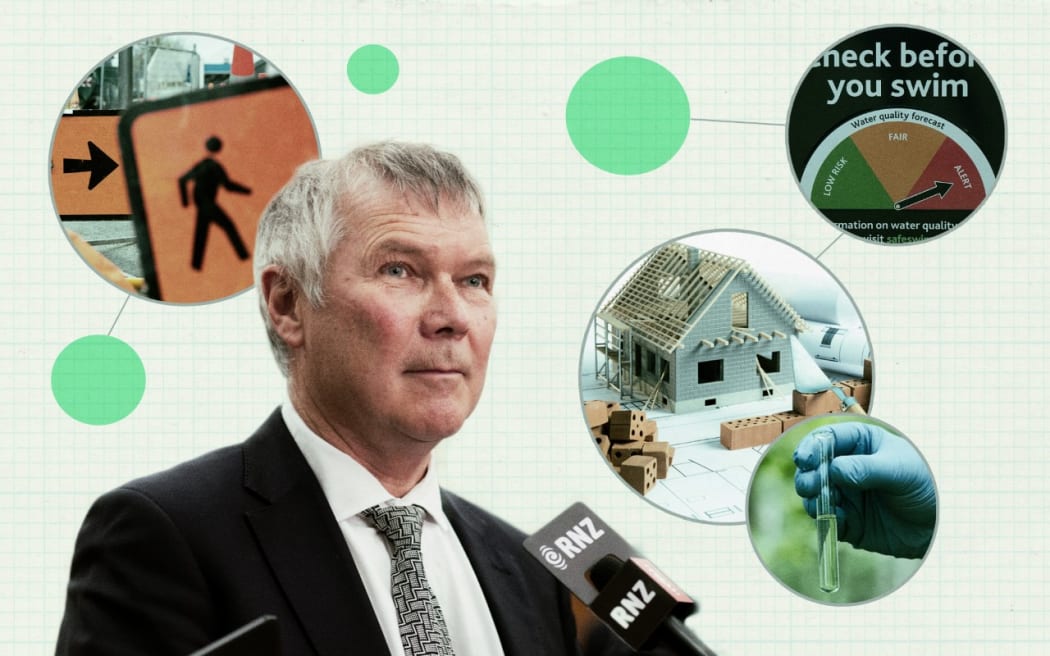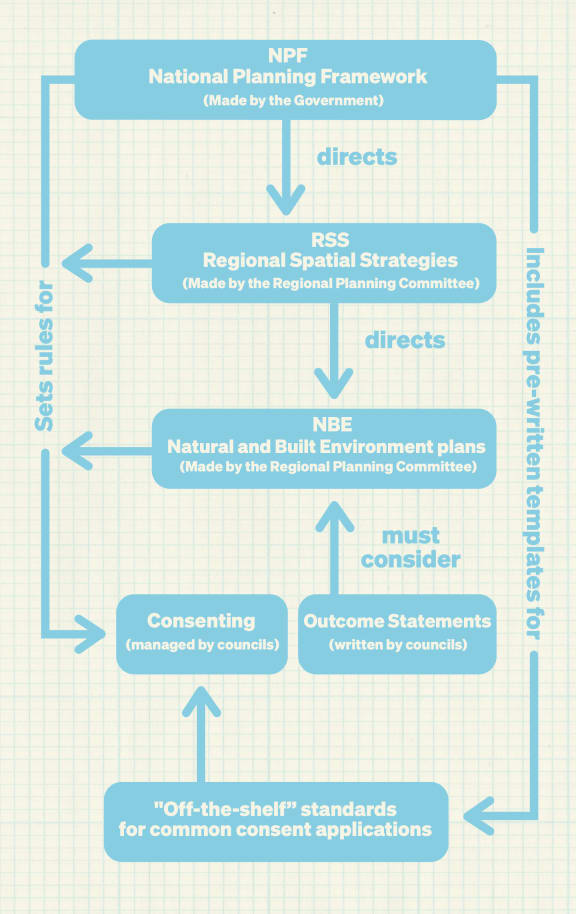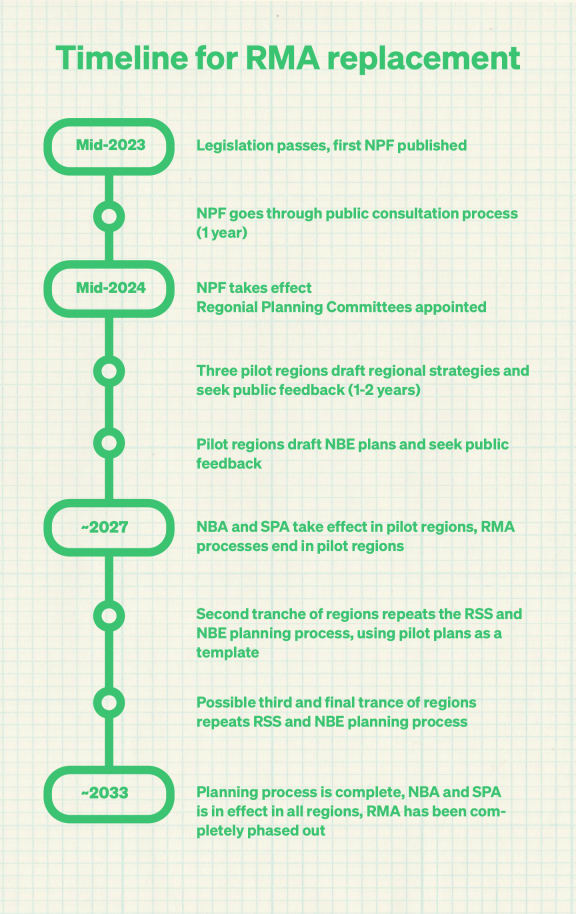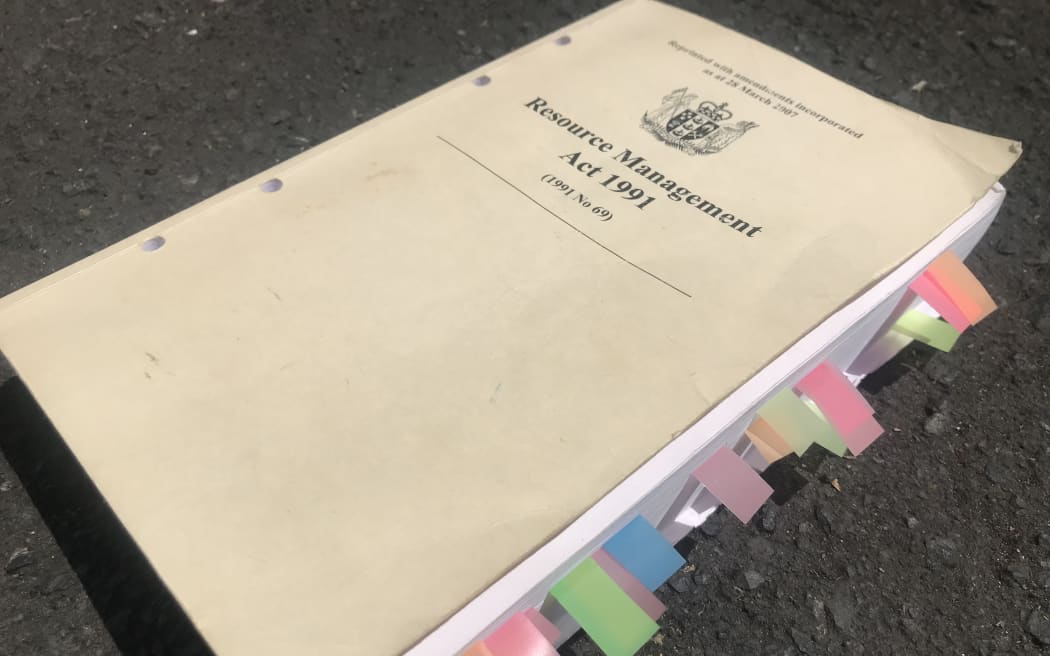
Photo: RNZ
Explainer - Back from the dead, cobbled together from old parts, and handed over to the NBA: It's not Frankenstein's monster playing basketball, it's the Resource Management Act (RMA).
The old RMA - itself an ambitious attempt to combine multiple laws into one system - is widely regarded as having failed to achieve its aims: The environment suffers while development and infrastructure costs more and takes longer.
However, the government's proposal to fix it is, arguably, just as complex - and other parties in Parliament were not enthusiastic at first blush.
The old law - with more than 1000 additions over three decades - runs to 890 pages. Two of the bills set to replace it already total 891, and there's a third one yet to come.
Page numbers don't necessarily translate to efficiency though, and the government is adamant the new system will make it easier to get things done while ensuring real protections for nature.
RNZ spoke to the reform programme's biggest supporter, Environment Minister David Parker, about how it would really work, how he hopes it will make things easier, and why it's all so complicated.
A restructuring, in three Acts
The RMA we all know and loathe is set to be replaced by not one, but three new pieces of legislation.
Two of them - the Natural and Built Environment Bill (NBA), and the Spatial Planning Bill (SPA)- were introduced to Parliament in November. (When they pass into law, they'll turn from "Bills" to "Acts of Parliament", hence NBA not NBB, and the NBA also makes changes to some other current laws like the Fisheries Act.)
The NBA and SPA set out how the consenting and building system will work in future, how planning will take place, and how the environment will be protected.
Public submissions on these proposed laws close on 5 February 2023, and the legislation is expected to be passed next year, before the general election.

Environment Minister David Parker Photo: RNZ / Angus Dreaver
The third bill, the Climate Adaptation Bill (CAA), is set to be introduced next year and passed in 2024. This would establish the systems and mechanisms for protecting communities against climate change's effects - like managed retreat from coastlines as sea levels rise - and set out how this is paid for and who's footing the bill.
Parker expects the new system will be better for all involved.
"There's a bit more front-end planning, a few more standards, a lot more becomes permitted, but it's all against the background of clear limits and targets so that as you do all those things, you're still protecting the environment," he says.
"It's better for the environment, it's better for developers, it's better for homeowners, it's better for councillors. Councillors will actually enjoy it more too, we know that they're pretty frustrated with the operation of the system. So it's better, faster, cheaper."
Something borrowed
The government says its new legislation will be the most significant change to New Zealand's resource management systems in decades.
However, Parker says some parts of the old system are working well, and it's not worth throwing the baby out with the bathwater.
"Quite a bit of it is carried forward," he says. "There's a tension here, do you start afresh with everything and throw everything up in the air and have uncertainty as to what the law means? Or where the law is working well - or parts of the law are working - do you just transfer over that same language?"
Core parts of the system will remain:
- Consenting is largely the same process, applies to the same things, and will still be managed by councils - although some of the categories of consents the government considers unnecessary are being removed
- Councils will continue to enforce consenting requirements, although their enforcement powers are being boosted with more funding and new tools
- The Environment Court will continue to do its job - dealing with appeals about the regional and district plans, and appeals against resource consent decisions - with additional powers to intervene and if the minister of the day decides it should (based on defined criteria), and hear evidence for changing regional plans
- The Parliamentary Commissioner for the Environment will still perform its role, carrying out investigations and providing advice to decision-makers about the environment
- The way land and bodies of water are used won't change overnight, but planning may pave the way for changes in future
- The fast-track consenting legislation brought in during the Covid-19 pandemic will be retained, transferred to the new Acts
- Planning will still be done through long-term regional plans, although their number and form is changing (explained below)
Plans upon plans
The major changes for getting things done - the 'built' part of the NBA - are largely focused on a more consistent planning regime, and there's several layers.
"The new system front-ends with better planning a lot of the things that are currently done on a case-by-case basis," Parker says.

Photo: RNZ
The top layer is the new National Planning Framework (NPF) - a document produced by the minister - which sets out national priorities and environmental limits. More on that later.
The next layer down is the Regional Spatial Plans (RSS, provided for in the SPA) setting out each region's long-term planning priorities. These would set out rules for things like intensification and city boundaries. They plan for 30 years ahead.
"The Spatial Plan sets out a long-term strategy for the region as to where you should next build, and where you shouldn't build; if you're going to build in that area, where you're going to need roads and rail and hospitals and that sort of thing," Parker says.
They would also include details on areas that need extra environmental protection, and agencies like Waka Kotahi would be required to factor in RSS planning, so spending on new motorways aligns with planning for new housing and can support planned growth.
These RSS plans would be developed by Regional Planning Committees with members from councils, central government, and at least two appointed by local Māori.
If the government changes the NPF, the committees will need to amend the RSS and NBE plans to make them comply, but can then skip the consultation process because the change would already have been through that with the NPF change.
There will be 15 committees: one for each region in the country, with Nelson and Tasman counting as a single region. The government has set a minimum of six members on each committee, and no upper limit on membership numbers - the actual number will be set by the committees themselves.
These groups are also responsible for designing the next level down: Natural and Built Environment (NBE) plans, which set out specific land use and resource allocation for each region.
Parker says the RSS and NBE plans are similar to the regional and district RMA plans already produced by councils, but will cut the number of total plans from more than 100 to 30 (15 RSSs, 15 NBE plans), leading to a more unified approach across the country.
"The function of those plans is the same. But they'll be a lot easier to use because they'll all be laid out in the same way and the unnecessary differences will be effectively pushed aside," Parker says.
In a change from the RMA, they will also go through a thorough public consultation process - with submissions, hearings and review by an independent panel - and would require engagement with mana whenua.
Each aspect of the NPF, RSS and NBE plans is required to be reviewed at least once every nine years.
Individual councils would still have a say, with outcome statements setting out their own priorities and needs. The committees will have to take these into account when designing their plans.
Finally, there's the promised "off-the-shelf" standards - which will be set out in the NPF next year.
Basically, these will mean people applying for a consent don't need to reinvent the wheel and get assessments of all the effects it could have - they'll just use a blueprint for similar consents.
"You could have Standard A for silt control, B, C, and D; and the applicant could say 'we think this is just pretty simple, we think standard A's fine," Parker says.
"The council could say 'oh, no, look, there's a bit more risk and we think you should use standard C', but you still don't have to set out the content ... it's already been prepared. So, that will save a lot of money."
Reduced consenting
When a person wants to do something to or on the land (or a coast, or lake, etc), laws and regulations set out whether that's allowed.
Just like under the RMA, this would in future be done by classifying different activities, although the new legislation would reduce these down to five:
- Permitted activities are allowed by default - they do not require a resource consent but may be subject to other requirements.
- Permitted with notice activities will be allowed by default but will require those affected in the area to be made aware - or "notified" that it's happening.
- Controlled activities are planned for (in the NPF, RSS or NBE plan), but have additional conditions or requirements attached because they may have some effects (eg. traffic) that need to be monitored or managed. There are two major changes from the RMA system for controlled activities: they will now be able to be rejected by consenting authorities, but only those people specifically listed in the plans will need to be notified rather than figuring that out on a case-by-case basis.
- Discretionary activities will be those that have not been planned for and therefore require a resource consent. Under the RMA this accounts for the vast majority of consented activities but is applied very unevenly across the country.
- Prohibited activities are, essentially, illegal. No person is entitled to apply for a resource consent for the activity and no consent authority has power to grant a consent for the activity. Plans will set out which activities are prohibited.
These categories can be applied at a national level through the NPF, at a regional level - or for a specific smaller area (known as a "management unit") through the RSS or NBE plans.
The benefit of the plans is they account for future development options, meaning more activities will be "permitted" and won't need to apply for a consent at all.
"Those activities that have been signalled in advance can then move into your Natural and Built Environments Act plan ... people can effectively be allowed to do that as a permitted activity," Parker says.
If a consent is needed, the process would be quicker because the requirements for getting a consent are more clearly stated from the outset, with the standards meaning applicants won't need to prepare quite so much.
Under construction: The National Planning Framework
The NPF must, according to the legislation, be in place at all times. Parker says the first one is expected to be ready to go out for consultation by the time the legislation is passed next year.
It gives the government flexibility to set the overall expectations and direction for infrastructure and planning for the long term, without having to worry too much about location-specific details.
It can be changed by an Order-in-Council - meaning the government can make changes whenever it likes (although the laborious consultation process it must go through will mean they don't want to do it too often) and achieves three main objectives.
First, it will be a more unified combination of more than 20 national policy statements and other government documents which currently set the national direction for resources and planning.
These include things like air and freshwater quality, climate change adaptation, areas of highly productive land, electricity transmission and renewable energy, urban development, indigenous biodiversity, medium-density housing rules, and more. This will also have to be consistent with the government's emissions reduction and national adaptation plans.

The NPF will include Photo: Romolo Tavani/123RF
Second, it will also have new aspects the government has identified as priorities, including infrastructure and development corridors, urban development, urban forests, and non-commercial housing and papakāinga on Māori land.
The most significant of these is expected to be a full chapter about infrastructure which is currently being written by Te Waihanga, the Infrastructure Commission.
This will also speed things up and aims to avoid having to make decisions multiple times: where infrastructure is identified in either the NPF or in regional plans, the planning committee is banned from considering alternative options or considering whether that infrastructure is necessary for the goals outlined in the NPF or regional plans.
Parker says urban forests and trees - a topic which received much attention during the initial select committee inquiry and has been a focus for the Green Party - will also be made a priority for councils through the NPF.
Third is the environmental aspect. This is the 'natural' part of the NBE, and is a significant change in approach - enough that it deserves to be explained in detail...
The upper limit: Environmental protection
The old RMA system aimed to protect the environment by restricting developments that had negative effects on the environment.
This meant whenever someone wanted to do something like build a house, they would need to check it didn't affect things like local streams; complied with regulations related to boundaries and didn't restrict the views of other houses; and so on.
It even took into consideration things like "heritage values" and "amenity" - something the new law will specifically rule out of contention.
But it failed to protect the environment. Parker says the case-by-case approach did not deal well with cumulative effects: straws breaking the proverbial camel's back.
For example, someone building a house would get an assessment showing sediment and bacteria would have little effect on a local stream, and the council would therefore allow it. The problem is if another thousand houses are being built, those little effects add up.
So instead, the new system would have biophysical limits for things like water quality, air pollution, or noise.
These could be set as a minimum state of the environment (eg, poor water quality, set through scientific measurement), or a maximum amount or harm or stress to the environment (a certain amount of chemical allowed to be released).
They would be monitored closely by councils (and, sometimes, other groups) and consenting could be adjusted in one area or another based on how much the environment is affected.
"Once they're set, they'll be strictly enforced," Parker says. "There will be the very occasional exception for public-good infrastructure that can't be put somewhere else, but in general terms if you've got an environmental limit it's not meant to be breached."
Along with limits, targets can also be set. These would be where the current state of the environment is below the limit - unacceptably degraded - and only actions which improve it or completely offset any negative effects would be allowed.

Photo: 123RF
An example would be bringing a particular stream up to "swimmable" water quality levels, with developers required to do riparian planting along a riverbank to be allowed to build homes.
Limits and targets would be set through the NPF, or the NPF can direct the planning committees to include them in the NBE plans for targeting region-specific effects.
The legislation also provides for "adaptive management", allowing an activity to be monitored to ensure it remains within a series of strictly enforced limits which change over time.
Playing the long game
The whole programme is expected to take about 10 years to be rolled out. Parker says this delay is intentional.
"A lesson from the RMA is that if you try to do the whole of the country at once the system gums up and everything is delayed, so we decided that we'd be better to start with three regions," he says.

Photo: RNZ
Another reason is how long it takes to do the planning.
Current RMA plans take council committees about 10 years to fully draft.
Parker expects the new system will cut it down to four years - and indeed, the legislation would set that as a hard deadline for the first plans - but there's still a process which must be followed including seeking feedback from the public.
Parker says when the new laws take effect in a region, the old RMA processes will be completely switched off in that region: no side-by-side operation of two laws.
He says the government has not yet decided which regions the new system will be trialled in, but they will include at least one region from the North Island, and one from the South Island.
The new system would then be rolled out to the remaining regions of the country - either split into two groups, or all at once depending on how things are going.
He's also confident the National Planning Framework at least would survive a change of government.
"Actually, if you look historically, there hasn't been too much yo-yoing of the existing national direction," he says.
"The existing national direction that we have for water and air, protection of soils and the like, and intensification of housing … was passed with cross-party agreement in the last year or two - that's been in place for a while. And of course, the country needs it in some form.
More involvement for Māori
The RMA interacts with more than 60 Treaty settlements and those interactions will be carried over into the new legislation.
One of the stated objectives of the new legislation is also to "give effect to the principles of te Tiriti o Waitangi and provide greater recognition of te ao Māori, including mātauranga Māori".
The "give effect to" terminology is a more active requirement compared to the old RMA wording which requires the principles to be "taken into account". The new language brings it in line with the Conservation Act.
A new National Māori Entity will be set up to monitor the government's Treaty responsibilities under the new system, as well as being one of the groups tasked with assessing the system's overall effect.
The entity will be a body corporate and must be independent of Māori groups, government ministers and agencies, and any other groups given powers and responsibilities under the bills.
It will have seven members each appointed for up to six years - on a rolling basis - by the minister, based on nominations by iwi, hapū or Māori. Between them the members will need experience and knowledge of te Tiriti, tikanga Māori, mātauranga Māori, monitoring and reporting, knowledge of the law, communications and governance.
The entity will be able to change its name if it wants, and will be audited by the Auditor-General.
Planning committees will also be required to consult with iwi and hapū groups affected by their plans, and these groups will be able to at any time submit a statement on te oranga o te taiao, which roughly translates as 'the wellbeing of the environment'.
The legislation describes it as: "a te ao Māori concept that speaks to the health of the natural environment, the essential relationship between the health of the natural environment and its capacity to sustain life, and the interconnectedness of all parts of the environment".
The Environmental Defence Society has urged the government to provide a fuller explanation. The legislation does not require anything be done about these statements.
Finally, the legislation would also set up a new Freshwater Working Group, which would provide recommendations on allocation.
There is also a clause within the legislation which states any rights or interests in freshwater or geothermal resources are preserved, consistent with a 2012 High Court ruling.
How long is a piece of red tape?
One of the criticisms levelled at the legislation is its length and complexity.
The NBA and SPA bills combined total 891 PDF pages - exactly one more page than the RMA - but this includes general policy statements and clause-by-clause analysis that will drop out once it passes through Parliament.
Parker says the final product will be about 20 percent shorter, even including the fast-tracking process accounts for about 100 pages and currently is contained in a separate Act.

The current RMA legislation is 890 pages long. Photo: Bill McKay
The new bills also use a more modern style: more bullet points make it easier to interpret but with the same amount of words taking up more space.
Even so, a lengthy piece of law. Parker argues it's the nature of the beast, and compares it to Australia's equivalent - an 800-page federal statute plus a roughly 600-page statute for each state.
"You're covering how you deal with land use and development for things as varied as protecting the air, the soil, your sea, what you're doing about development, housing, infrastructure. This touches every aspect of life, so it would be nice if you could cover it in a few pages, but no other country seems to achieve that either. "
He says the law needs to be specific about many of these aspects or it would leave too much uncertainty. This means lists of how, for example, coastal waters are handled and who has authority over maritime areas.
But mostly, he's adamant front-loading regulations into regularly updated plans will make the system work more smoothly.
"We think we are reforming it to make it simpler and easier and cheaper. In fact, we've I think we've got very good analysis to show it will be simpler, cheaper, and it'll be better for people to use."
Counting the cost
That cost-benefit analysis has already received media attention, but for completeness here are some of the main findings:
- Total Ministry for the Environment cost-benefit analysis predicts costs of $3.891b and benefits of $10.039b. This doesn't account for non-monetary benefits like environment protection.
- Total establishment is expected to cost $864m for central government AND councils, over 10 years.
- Conservative estimates predict $2.85 in benefits for every dollar spent over that time - or $4.90 under more "realistic" estimates.
- Planning processes and other spending to set the system up will increase the cost for central government by an estimated 112 percent.
- For councils, overall costs are expected to increase about 11 percent. This includes developing and monitoring new economic instruments ($27m a year); increased monitoring and enforcement ($18m a year) and review and compliance with the NPF ($15m a year). Some of the government's establishment funding will support councils, but they'll be expected to foot some of the bill themselves.
- Consenting costs between 2014 and 2019 increased by 66 percent (notified) and 124 percent (non-notified), taking on average 50 percent longer. It currently accounts for about 5.5 percent of total project cost - totalling $1.3b a year across New Zealand - compared to between 0.1 percent and 5 percent in Europe. The new system is expected to cut costs to system users by 19 percent ($150m a year).
- The government has already allocated: in 2021, $131.8m for design, enactment, transition, capacity building, initial implementation; in 2022 a further $179m, to be spent over the next four years.
The government is also putting some extra money in to help with the new plans and extra monitoring and enforcement requirements.
Parker says the consenting system will be cheaper for councils to operate, and he expects those cost savings to be passed on to ratepayers.









